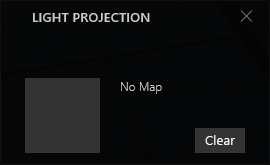The light panel allows developers to assign, set and remove lights of shapes in the light panel.

The light panel contains these controls:
| Control | Action | Remarks |
|---|---|---|
 |
Select the prior light. | |
 |
Select the next light. | |
 |
Open a list with all available lights. | Select a new light with a double click. |
 |
Copy the light. | |
 |
Remove the light. | |
 |
Assign a new light. | |
 |
Opens the light settings window to configure basic light properties. | |
 |
Opens the light design window to configure design properties. | |
 |
Opens a projection window to select a projection texture. | The texture applies only for projected lights. |
 |
Opens a the light lens flare window to bind a lens flare to this light. | Lens flares are bound to lights. |
| Information below | Tje name, type position and color of a light. | If a light is selected. |
The light settings window gives developers the ability to change basic properties for lights.

The light settings window contains these controls; the list is grouped from left to right:
| Control | Action | Remarks |
|---|---|---|
 |
The position of the light on the x-axis in object space. | Right to the position row. |
 |
The position of the light on the y-axis in object space. | Right to the position row. |
 |
The position of the light on the z-axis in object space. | Right to the position row. |
 |
The yaw roation in degree angle in object space. | Right to the direction row. Directions: 0 = forward, 90 = right, 180 = backward, -90 / 270 = left. |
 |
The pitch rotation in degree angle in object space. | Right to the direction row. Directions: 0 = up, 90 / -90 = horizontal, 180 = down. |
 |
The radius of the light. | Right to the direction row. |
 |
For area and circle lights: the size of the rectangle on the x-axis or of circle lights the radius of the circle. | Right to the extends row. |
 |
For area lights: the size of the rectangle on the z-axis. | Right to the extends row. |
 |
For line lights: the length of the line. | Right to the extends row. |
 |
The type of the light. |
The light type describes how the light intensity is computed for a given point. These light types are supported: point lights, spot lights, line lights, area lights, circle lights and projected lights. |
 |
The inner distance. | If a point is inside this sphere, it does not get lighted by this light. |
 |
The inner cone angle in degree. | |
 |
The outer cone angle in degree. | |
 |
The rotation of the emit direction of the line light. | Only applied for line lights. Directions: 0 = down, 90 / -90 = horizontal, 180 = up. |
The light design window gives developers the ability to design the appearance of the light.

The light design window contains these controls:
| Control | Action | Remarks |
|---|---|---|
 |
Select the type of the emitting light source. | The light type desribes how much light energy is emitted per watt. Edison Builb: 17.5 cd / W Flourescent: 75 cd / W Halogen: 24 cd / W LED: 100 cd / W Mercury Vapor: 65 cd / W Metal Halide: 95 cd / W Sodium High: 200 cd / W Sodium Low: 130 cd / W |
 |
The power of the light source in Watt. | |
 |
The emitting radius of the light. | |
 |
The color temperature of the light. | Drag the slider to set the color temperature. For example, 3700 K is warm white and 6200 K is daylight. If you move the slider, also the color control is set and overwritten. |
 |
Click the control to select a color manually. |
The light projection window gives developers the ability to set the projection texture for a projected light.

The texture control opens a window with a list of available textures. Select a texture with a double click. You may remove a projection texture with the clear button.
The light lens flare window gives developers the ability to bind a lens flare to a light.

The  control opens a list with available lens flares. In this window, select a lens flare or remove it.
control opens a list with available lens flares. In this window, select a lens flare or remove it.
Once a lens flare is bound to a light, it will be rendered.
Information about how to design a light, the limitations of the system and available performance, read the "Lights" page in the creators section in this documentation.